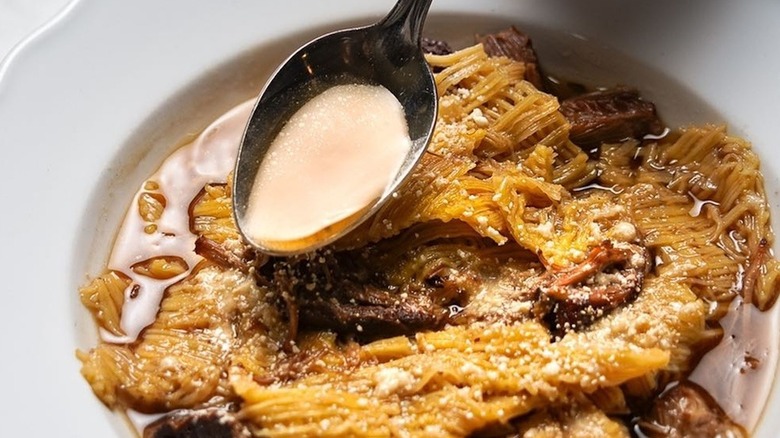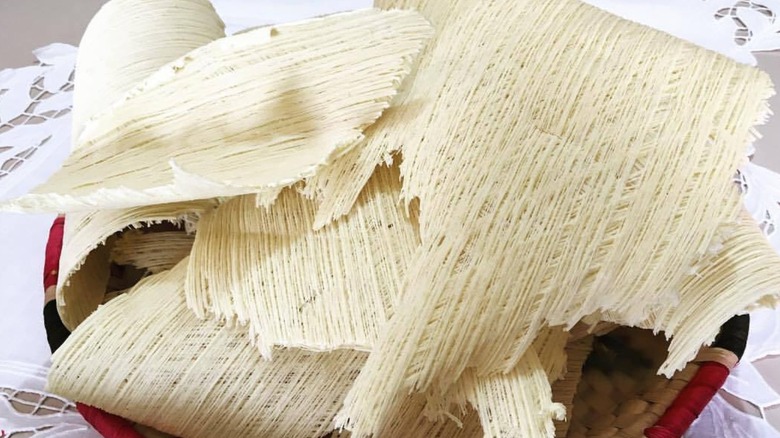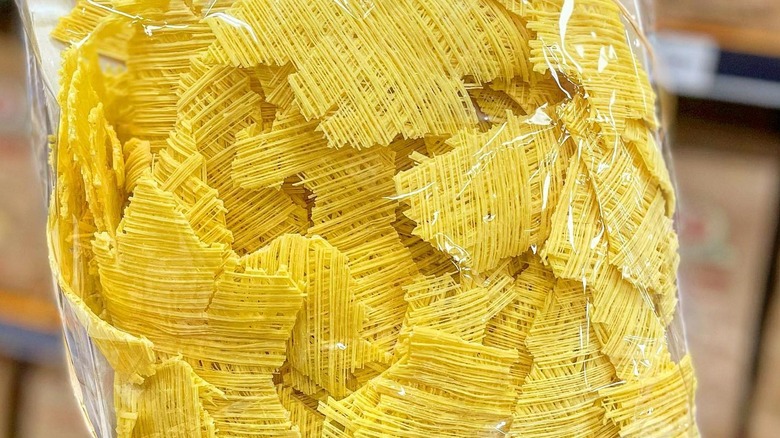The Rarest Pasta In The World Requires A 20 Mile Hike To Eat It
Tucked away in the mountainous interior of Sardinia is the small Italian town of Nuoro. It's here that three women from the local Abraini family make "su filindeu" — one of the rarest pastas in the world. Crafted from thin strands of dough that are pulled out by hand to about half the width of angel hair, these delicate strands give the pasta its name. In English, it translates to "the threads of the gods." After being pulled, these strands are formed into a wide but extremely thin lattice ready for sauce and broth.
To this day, the pasta is mostly reserved as a meal for the twice-yearly fest called the Feast of San Francesco. Participants must undertake an arduous, 20-mile hike from Nuoro to a sanctuary in the village of Lula. The journey is made on foot in accordance with a local legend about the founder of the sanctuary, with travelers walking the path in honor of a similar trek he made. After hiking through the inhospitable central Sardinian terrain, the pilgrims are welcomed with a foot bath and a steaming bowl of soup flecked with su filindeu.
The history and future of su filindeu
Although mentions of su filindeu date to back to the late medival period, how and when the Abraini family became involved has been lost to time. What is known is that Paolo Abraini's ancestors have safeguarded how to make it for at least 300 years. Today, she makes the pasta with her sister-in-law and niece, just as the women in her family have done for generations.
In the 21st century, the pasta's legend is growing. In 2016, Jamie Oliver attempted to learn how to make it for his show "Jamie's Super Food." After trying to imitate Abraini's noodle-pulling procedure, Oliver threw his hands up and admitted he couldn't do so without breaking the pieces. Clearly this is a process on a different level than whipping up some handmade lemon pappardelle.
In fact, Paolo Abraini (who is around 64 years of age) has found it difficult to pass on the recipe to a younger generation in her family, as those who know the technique do not have children. As such, the dish has been listed in the Ark of Taste, a catalog made by the Slow Food Foundations for Biodiversity of traditional recipes and techniques that are in danger of going extinct.
For the first time in three centuries, Abraini has begun teaching the dish to people outside of her family to allow it to survive. She and her students have begun preparing batches for a scant few international restaurants and Italian specialty shops, though it remains commercially unavailable online.
Making the world's rarest pasta
According to Paolo Abraini, the technique to make su filindeu relies on bone-deep instincts regarding how to handle, moisten, and stretch pasta dough. It all starts with a simple mix of durum wheat, semolina, salt, and water, which she carefully kneads to a clay-like consistency. She then rolls the dough into a tube, stretches it out, folds it over, and stretches it again.
Repeating this process once is difficult, as it takes great control to not have the dough break while stretching. However, Abraini repeats it a whopping eight times to create tiny strands of noodles. These are layered over a large, flat disk and set outside to dry in the sun until they've formed into crisp lattices. Finally, the large sheets are broken up into individual pieces which are saved for the Feast of San Francesco, or shipped to the very few lucky commercial clients.
At the feast, pilgrims are served su filindeu cooked directly in a simple lamb broth; as with many thin noodles, it seems best to boil them directly in the sauce. This rustic presentation is accompanied solely by Pecorino Romano. Restaurants have taken a similar approach. At Toronto's Buca Osteria & Enoteca, for example, the noodles are presented in a mutton broth with sous-vide lamb neck. It's one of the few places to enjoy su filindeu outside Sardinia.



